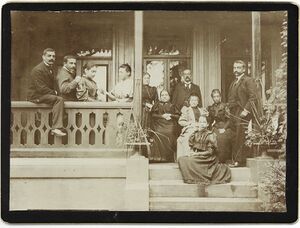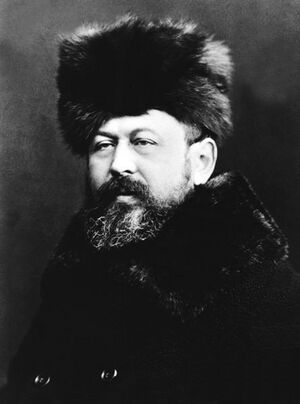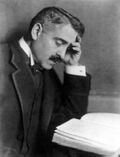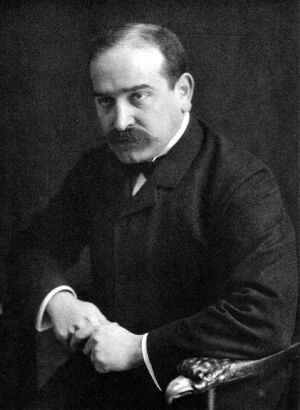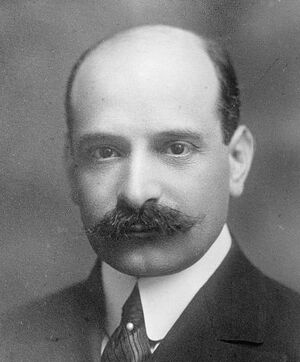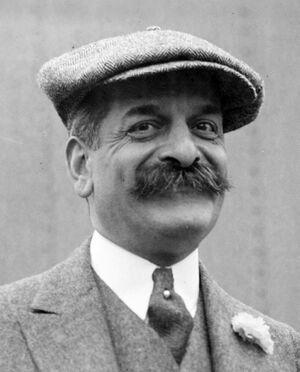عائلة واربرگ
عائلة واربرگ (إنگليزية: Warburg family، بالألمانية عائلة ڤاربورگ)، هي عائلة صيارفة يهود بارزين من ألمانيا وأمريكا ينحدرون من يهود البندقية، اشتهروا أيضاً بإنجازاتهم المتنوعة في الكيمياء الحيوية وعلم النبات والنشاط السياسي والاقتصاد والبنوك الاستثمارية والقانون والفيزياء والموسيقى الكلاسيكية وتاريخ الفن وعلم الصيدلة والفسيولوجيا والتمويل والمحاصصة الخاصة وعمل البر.[1]
كان لعائلة واربوگ تأثيراً كبيراً على الخدمات المصرفية الأوروپية. يمكن إرجاع القصة الملحمية لعائلة واربرگ من المصرفيين الأوروپيين إلى أوائل القرن السادس عشر عندما استقر سايمون فون كاسيل في مدينة واربورگ الألمانية في وستفاليا (التي أسسها في الأصل شارلمان عام 778 وكانت تُعرف بعد ذلك باسم واربورگوم) وبدأ سعي العائلة للحصول على المال والقوة المالية. على الرغم من تفوق عائلة واربورگ في العديد من المهن الأخرى في جميع أنحاء أوروپا، إلا أن هذه العائلة هي التي أنتجت بعضًا من أنجح المصرفيين في العالم. بفضل العقول الحادة والحس التجاري الجيد، اكتسبت أجيال عائلة واربورگ أموالًا وقوة لا حدود لها على ما يبدو.[2]
وفي القرن الثامن عشر انقسمت العائلة إلى مجموعتين. ذهب البعض إلى ألتونا بالقرب من هامبورگ في القرن 17، بعد حرب الثلاثين عام بألمانيا. على الرغم من إبعادهم إلى الأحياء اليهودية، ويُشار إليهم بموجب القانون باسم "المرابين" وليس المصرفيين، فقد أسس أحد أفراد عائلة واربورگ عام 1774 شركة "س. ج. واربورگ" للخدمات المصرفية التجارية. وسرعان ما ذاع اسم الشركة مع نمو العائلة وبدأ الأبناء والأحفاد في المساهمة في أعمال العائلة. عام 1807، بيعت أعمال عائلة واربورگ في ألتونا إلى العائلة في هامبورگ، لتتأسس شركة "م. م. واربورگ وشركاه"، التي أسسها موزس وگرسون واربورگ عام 1798.
عندما غزا ناپليون ألمانيا، استولى الجيش الفرنسي على هامبورگ عام 1804، وكذلك جگرسون شقيق موزس. احتجز ناپليون نفسه گرسون كرهينة وطالب بفدية من الجالية اليهودية بأكملها في هامبورگ مقابل إطلاق سراحه. ومع ذلك، فإن موزس شقيق گرسون لم يدفع المبلغ. ولم يتمكن موزس أخيرًا من دفع المال إلا بعد ضغط هائل من الجالية اليهودية، والذي كان لا يزال مبلغًا أقل بكثير مما كان متوقعًا منه. على الرغم من هذا النقص في الولاء، دخل الأخوان شراكة عام 1810، وقاما بتوسيع م. م. واربورگ معاً.
كانت نهاية الحروب الناپليونية بمثابة بداية إعادة البناء الاقتصادي لألمانيا. عندما انسحب الفرنسيون عام 1814، رأى موزس وگرسون الحاجة إلى تجديد مخزون البلاد من العملة الفضية لتعزيز الاقتصاد الألماني.
التاريخ
أقدم سلف معروف لعائلة واربرگ هو أنسلمو آشر لـِڤي دل بانكو (1480-1532). في بداية القرن السادس عشر، كان دل بانكو أحد كبار رجال المال والرهن في مدينة البندقية التجارية الإيطالية. وبموجب مرسوم صادر في 29 مارس 1516، قررت حكومة البندقية عزل الجالية اليهودي في منطقة واحدة. وبعد المزيد من القيود، غادرت عائلة دل بانكو البندقية واستقرت في إمارة هس التابعة للإمبراطورية الرومانية المقدسة.
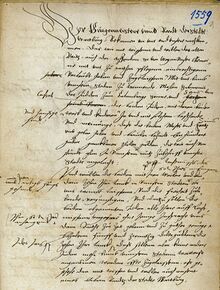
منذ عام 1556، عمل سيمون دل بانكو (1500-1566) كمقرض للمزارعين وتجار الحبوب في كاسل، مقر إقامة فليپ الأول. وبعد تفتيش المنزل، غير دل بانكو اسمه إلى سيمون فون كاسل خوفًا من المزيد من الانتقام والانتهاكات، ومن أجل الاندماج في المجتمع. من خلال هرفورد وبكوم، استقر سيمون فون كاسل أخيرًا عام 1557 مع زوجته وأطفاله وخدمه في مدينة ڤاربورگ الهانزية في وستفاليا، في أسقفية الأمير بادربورن. في ڤاربورگ، في 3 يناير 1559، مُنح دفعة لمرة واحدة قدرها 100 ثالر بالإضافة إلى رسوم سنوية أخرى يدفعها مجلس مدينة ڤاربورگ لفترة زمنية محدودة. حتى القرن التاسع عشر، كان اليهود بحاجة إلى تصريح للإقامة. كان عليهم دفع رسوم مقابل ذلك، وفي الوقت نفسه كانت خطابات الحماية هذه تضع أحيانًا شروطًا صارمة لإقامتهم. على الرغم من أن الحظر المفروض على الفائدة لم يعد ساريًا، إلا أن المدينة كانت بحاجة إلى مقرضين من ذوي الخبرة. وبالتالي، أصبح النشاط الاقتصادي لعائلة واربرگ هو إقراض الأموال. تم تمديد تصريح الإقامة، الذي كان محدودًا في البداية بعشر سنوات، مرارًا وتكرارًا من قبل أمير أسقفية بادربورن، بحيث بقيت العائلة في وستفاليا لمدة 100 عام تقريبًا. من الواضح أن العائلة اكتسبت الثروة والهيبة خلال ذلك الوقت. بعد بضع سنوات، تبنى سيمون فون كاسل أخيرًا اسم واربرگ كاسم عائلو جديد كمنذ ذلك الحين يُعتبر الجد الأكبر لعائلة واربرگ.
شجرة العائلة
خطا ألستروفر و ميتلڤگ
تنقسم العائلة تقليديًا إلى خطين رئيسيين، ألستروفر واربرگ وميتلڤگ واربرگ. ينحدر خط ألستروفر واربرگ من سيگموند واربرگ (1835–1889) وينحدر عائلة ميتلڤگ واربرگ من أخيه موريتس واربرگ (1838–1910). وأخذوا ألقابهم من ألقاب الأخوين في حي رثرباوم في هامبورگ. كان الأخوة أحفاد موسز ماركوس ڤاربورگ.[1]
ينحدر سيگموند گيورگ واربرگ من خط ألستروفر؛ وكان الإخوة الخمسة أبراهام (آبي)، ماكس، پول، فيلكس، وفريتس موريتس واربرگ من خط ميتلڤگ.
عام 1798 أسس الأخوان موسز ماركوس ڤاربورگ (1763–1830) وگرسون ڤاربورگ (1765–1826) مؤسسة ڤاربورگ المصرفية. وفي لندن عام 1946 أسس سيگموند گيورگ ڤاربورگ، حفيد موزس، بنك س. گ. ڤاربورگ وشركاه. وفي نيويورك عام 1938 أسس إريك واربرگ، ابن عم سيگموند الثاني، واربرگ پنكس. أما ماكس واربرگ الابن، ابن إريك واربرگ (يجب التفرقة بينه وبين ماكس واربرگ والد إريك) هو حاليًا أحد الشركاء الثلاثة لشركة م.م. ڤاربورگ وشركاه. استخدم آبي ڤاربورگ، شقيق ماكس ڤاربورگ الأكبر، موارد الأسرة لتأسيس كولتورفورشونگه بيبليوتيك واربرگ في هامبورگ، منذ عام 1934 معهد واربرگ في لندن.[3] يُعرف پول واربرگ بأنه معماري[4] نظام الاحتياط الفدرالي الأمريكي، الذي تأسس عام 1913. كان پول عضواً في مجلس الاحتياط الفدرالي الأول، وكان نائباً للمجلس حتى استقالته في أغسطس 1918.[5][6][7][8]
واربرگ الأمريكية وڤاربورگ الألمانية
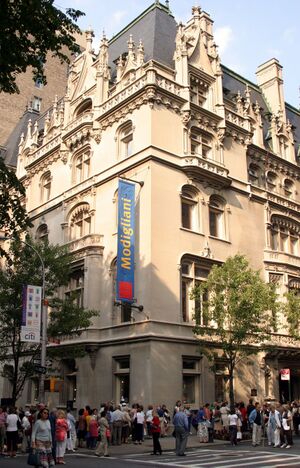
هاجر فليكس وپول واربرگ الولايات المتحدة. وهناك أصبحا الدعامتين الرئيسيتين للفرع الألماني-الأمريكي للعائلة، من بين الأخوة واربرگ الخمسة الذين وُلدوا في ألمانيا. عمل الأخوان في مدينة نيويورك حيث شكل جميع الأعضاء الذكور تقريبًا رابطة وثيقة مع شركة كون، لوب وشركاه للخدمات المصرفية الاستثمارية. وهي شركة مقرها أمريكا لكنها تتمتع بسمعة دولية جيدة، وكانت تفكر ذات يوم في إنشاء فرع بالخارج يُفترض أنه سيعمل بكفاءة أكبر بمساعدة العلاقات الدولية للعائلات. أثناء وجوده في مدينة نيويورك، تزوج فليكس من فريدا شيف، الابنة الوحيدة لجاكوب شيف، وهو مصرفي نشأ في فرانكفورت وكان له علاقات بعائلة ڤاربورگ الألمانية. قام شيف بتمويل معظم نظام السكك الحديدية الأمريكي من خلال البنك الاستثماري الخاص به، كون، لوب وشركه، وتفاعل مع عائلات واربرگ الأمريكية الجديدة، حيث أصبح كل من الأخوين فليكس وپول في النهاية شريكًا رئيسيًا، وتزوج كل منهما من بعض العائلات البارزة في شركة كون، ليوب وشركاه للخدمات المصرفية الاستثمارية، التي يديرها شيف في ذلك الوقت. بدءًا من زواج جاكوب شيف عام 1875 من تريس لوب، ابنة المؤسس المشارك سولمون لوب، ليصبح شريكًا كاملاً في الشركة بعد فترة وجيزة. عام 1895، تزوج پول واربرگ من نينا، ابنة سولمون لوب، بعد أن التقى بها في حفل زفاف شقيقه فليكس الذي تزوج ابنة جاكوب شيف، فريدا. لكن في الأصل كان الشريك المؤسس أبراهام كون هو الذي ركز ثروة العائلة وعزز العلاقات التجارية مع ابن العم البعيد المهاجر حديثًا، سولمون لوب، من خلال زواجه من شقيقة كون. وبعد فترة وجيزة أصبح الاثنان شريكين كاملين في شركتهما الاستثمارية المصرفية التي تم إنشاؤها حديثًا في نيويورك، كون، لوب وشركاه.[9]
لاحقاً، كان حفيد شيف الأكبر درو زوجاً سابقاً لكارينا ابنة آل گور، التي تولت منصبًا في معهد الاتحاد اللاهوتي. تشارك جامعة تورنتو في شراكة مع المعهد اللاهوتي اليهودي، ويقع كل منهما في منهاتن بمدينة نيويورك، حيث ارتبط المعهد اللاهوتي اليهودي تاريخيًا أيضًا بالمتحف اليهودي. نظرًا لوجود روابط مع أمريكا وألمانيا مثل العديد من العائلات المالية اليهودية البارزة الأخرى، حافظ آل واربرگ في الخارج على روابط وثيقة بجذورهم اليهودية. أصبح بيت فليكس م. واربرگ في مدينة نيويورك الآن متحفاً يهودياً، وسُمي موشاڤ كفار واربرگ في إسرائيل باسمه. كان أوتو ڤاربورگ، ابن عم عائلة ڤاربورگ التي كانت تعيش في ألمانيا، عالم نبات ثريًا انتُخب رئيسًا للمنظمة الصهيونية العالمية عام 1911. وكان پول شقيق فليكس واربرگ، أحد المؤسسين الأصليين لمجلس [10] الاحتياط الفدرالي الأمريكي، مجموعة من 12 بنك احتياط إقليمي يرأسها مجلس محافظين ينظم ويشرف على البنوك التجارية الخاصة.[11] باعتباره أحد أبرز المصرفيين في عصره، حضر شقيقه ماكس ڤاربورگ مؤتمر پاريس للسلام عام 1919 في ڤرساي، كجزء من الوفد الألماني.[12][13]
في عهد جمهورية ڤايمار، خدم ماكس ڤاربورگ في مجلس إدارة ""(Generalrat) الرايخبنك من عام 1924 حتى 1933، تحت رئاسة اثنين من الرؤساء المتعاقبين، هيالمار شاخت، (حتى عام 1930)، وهانز لوثر (1930-1933)؛ وحتى عام 1934، كان أيضًا عضوًا في مجلس إدارة بانكنفرباند.[14] هاجر ماكس ڤاربورگ عام 1938. وفي العشرينيات والثلاثينيات، حتى نهاية جمهورية ڤايمار عام 1933، خدم ماكس أيضاً في عدد من المجالس الإشرافية ("Aufsichtsrat") في الصناعة، وأبرزها HAPAG، Blohm &Voss, Beiersdor، وحتى استقالته عام 1932، كان عضواً في المجلس الإشرافي ("Aufsichtsrat") [15] على تكتل الشركات/الشركة الكيميائية الألمانية التي تُعرف باسم آي جي فاربن (Interessen Gemeinschaft Farben). كما خدم شقيقه پول ڤاربورگ، الذي توفي في يناير 1932-قبل عام من انتخاب هتلر مستشاراً-، في العديد من المجالس الإشرافية ("Aufsichtsrat") بما في ذلك مجلس إدارة شركة تابعة مملوكة بالكامل لفرع شركة آي جي فاربن في الولايات المتحدة.
فر معظم أفراد عائلة ڤاربورگ الألمانية إلى الولايات المتحدة أو بريطانيا العظمى بحلول نهاية عام 1938. ومع ذلك، ألقت الشرطة السرية الألمانية القبض على، فريتز ڤاربورگ، شقيق ماكس ڤاربورگ، الذي كان يستعد للهرب إلى السويد، في هامبورگ في أوائل نوفمبر 1938 وقضى بضعة أشهر في السجن قبل أن يتمكن من المغادرة إلى ستوكهولم في مايو 1939.[16] أشرفت ابنته إيڤا على تنظيم هجرة 500 طفل يهودي ألماني من ألمانيا والنمسا إلى السويد عامي 1938 و1939.[17] كما أقام في ألتونا ثلاثة أبناء عمومة، الأم گرتا والابنتان بتي وهيلن جولي (بورشارد) ڤاربورگ. قُتلت گرتا وبتي في معسكر سوبيبور عام 1940 وهلينا جولي في معسكر أوشڤتس عام 1942.[18][19][20] يوجد اليوم في متحف كونسهاوس في زيوريخ پورتريه بالحجم الطبيعي للفنان النرويجي إدوارد مونش (السيدة باللون الأبيض).[21][22] أما إريك، ابن ماكس ڤاربورگ، فقد عاد إلى ألمانيا كضابط (عقيد) في القوات الجوية الأمريكية[23] وكان مؤثراً في استعادة العلاقات الألمانية اليهودية[24][25] وإعادة بناء العلاقات الاقتصادية لألمانيا بعد الحرب العالمية الثانية من خلال جمعيات الأعمال الدولية.[26][27] ابن إريك، يسمى ماكس أيضاً، هو حالياً شريك في م. م. ڤاربورگ في ألمانيا.
أصول بندقية
يُعتقد أن عائلة واربرگ نشأت في مدينة البندقية، حيث حملوا لقب دل بانكو. تصف الوثائق التاريخية أنسلمو دل بانكو بأنه يهودي وكان من أغنى سكان البندقية في أوائل القرن السادس عشر. عام 1513، مُنح دل بانكو ميثاقًا من حكومة البندقية يسمح بإقراض الأموال بفائدة. غادر دل بانكو مع عائلته بعد فرض قيود جديدة على الجالية اليهودي تزامنًا مع تأسيس گيتو البندقية. استقرت العائلة في بولونيا، ومن هناك إلى مدينة ڤاربورگ الألمانية، وتبنت اسم تلك المدينة كلقب خاص بها، بعد انتقالها إلى هامبورگ بعد حرب الثلاثين عامًا.[28][29]
أعضاء بارزون
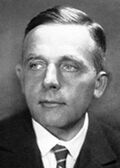
تتضمن شجرة عائلة واربرگ أشخاص يحملون لقب ڤاربورگ، وهم فرع العائلة في ألمانيا، أما من يحملون لقب واربرگ فهم فرع العائلة في الولايات المتحدة.
- موسز ماركوس ڤاربورگ (1763–1830)، مؤسس، مع شقيقه گرسون ڤاربورگ (1765–1825)، في م. م. ڤاربورگ وشركاه في 1798.
- سارة ڤاربورگ (1805–1884) المتزوجة من أبراهام صمويل ڤاربورگ (1798–1856)، ابن عمها[30] كريتانستالت
- روزا ڤاربورگ (1833–1908)، المتزوجة من پول شيف، المدير في كريتانستالت في ڤيينا
- سيگمنود ڤاربورگ (1835–1889)، المتزوج من ثيوفيلين رونزبرگ
- أبراهام صمويل ڤاربورگ (1864–1933)
- گيورگ گابرييل ڤاربورگ (1871–1923)
- Siegmund George Warburg (1902–1982)، مؤسس S. G. Warburg & Co، بلندن
- موريتس م. ڤاربورگ (1838–1910)، تزوج شارلوت أوپنهايم
- آبي م. ڤاربورگ (1866–1929)، مؤرخ فني ألماني
- ماكس م. ڤاربورگ (1867–1946)، مصرفي
- إريك م. واربرگ (1900–1990)، مؤسس واربرگ پنكس، تزوج دورثيا ثورش (1912–2003)
- ماكس م. واربرگ الأصغر (و.1948)
- ماري ڤاربورگ، تزوجت مايكل ناومان (و.1941)، صحفي
- إريك م. واربرگ (1900–1990)، مؤسس واربرگ پنكس، تزوج دورثيا ثورش (1912–2003)
- پول م. واربرگ (1868–1932)، أبو الاحتياطي الفدرالي، تزوج نينا لوب (1863–1912) في 1895، ابنة سولمون لوب
- جيمس واربرگ (1897–1969)، اقتصادي ومصرفي ومستشار فرانكلن روزڤلت، تزوج كاي سويفت (1897–1993)
- أندريا سويفت واربرگ، تزوجت سيدني كاوفمان.
- كاثرين كوفمان وبر (و.1955)، روائية تزوجت نيكولاس فوكس وبر.
- أندريا سويفت واربرگ، تزوجت سيدني كاوفمان.
- بتينا ڤاربورگ (1900-1990) الطبيبة النفسية.
- جيمس واربرگ (1897–1969)، اقتصادي ومصرفي ومستشار فرانكلن روزڤلت، تزوج كاي سويفت (1897–1993)
- كاثرين واربرگ (1870–1935)، تزوجت إيزاك دورفمان (1868–1929)، المصرفي ورجل البر.
- فليكس م. واربرگ (1871–1937)، المصرفي النيويوركي لدى كون، لوب وشركاه، رجل البر، تزوج فريدا شيف (1876–1958)، ابنة جاكوب شيف وحفيدة سولمون لوب في 1895.
- كارولا واربرگ روتشيلد (1896–1987)، تزوجت والتر ن. روتشيلد، ابن سيمون ف. روتشيلد[31]
- والتر ن. روتشيلد الابن
- فيليس روتشيلد پيترز فارلي
- كارول روتشيلد برادفورد نويس، تزوجت آموري هاو برادفورد (ت. 1998)، ابن آرثر هاو برادفورد؛ تزوجت في 1965 من الدبلوماسي تشارلز پ. نيوس
- ديڤد أ. برادفورد
- كارولا برادفورد ليا
- ماداڤي برادفورد
- دبورا برافدورد
- پيتر أ. برادفورد، تزوج كاثرين برادفورد
- آرثر برادفورد
- لورا روتشيلد برادفورد كيركپاترك
- فردريك ماركوس واربرگ (1897–1973)، تزوج ويلما ل. شانون[32]
- جرالد فليكس واربرگ (ح.1902–1971)، عازف التشيلو والمايسترو المشهور، تزوج ناتيكا ناست (1905–1987)، ابنة كوندي ناست مونترز ناست[33]
- پول فليكس واربرگ (ح.1904–1965)[34]
- إدوارد واربرگ (1908–1992)، رجل البر وراعي الفنون، تزوج ماري واربرگ (1908–2009)
- ديڤد واربرگ
- إيان واربرگ، تزوج جين گرين (1968–) المؤلفة وسيدة البر.
- دافن واربرگ (و. 1949)، تزوجت مايكل رامون لونگورن أستور، الابن الأكبر لجاكي أستور.
- ديڤد واربرگ
- كارولا واربرگ روتشيلد (1896–1987)، تزوجت والتر ن. روتشيلد، ابن سيمون ف. روتشيلد[31]
- أولگا ڤاربورگ (1872–1895)
- فريتز م. ڤاربورگ (1879–1962) عاش في ستوكهولم أثناء الحربين العالميتين الأولى والثانية، ووالد إيڤا ڤاربورگ التي نظمت هجرة الأطفال اليهود الألمان إلى السويد في 1938 و -39.
- لويزا ڤاربورگ (1879–1973)، تزوج يوليوس ڤاربورگ (1873–1928)
- ڤالتر يوليوس ڤاربورگ (1903–1975)، دارس قانوني
- سارة ڤاربورگ (1805–1884) المتزوجة من أبراهام صمويل ڤاربورگ (1798–1856)، ابن عمها[30] كريتانستالت
- الأقارب
- إميل ڤاربورگ (1846–1931)، فيزيائي ألماني
- أوتو هاينرش ڤاربورگ (1883–1970)، فسيولوجي وعالم كيمياء حيوي (جائزة نوبل في الطب، 1931)
- أوتو ڤاربورگ (1859–1938)، عالم نبات ورئيس المنظمة الصهيونية العالمية
انظر أيضاً
المراجع
- ^ أ ب "Warburg family". Encyclopædia Britannica. Retrieved 6 November 2013.
- ^ "5 - The Architect: Paul M. Warburg". مطبوعات جامعة كمبردج. 2023-08-16. Retrieved 2024-05-05.
- ^ "History of the Warburg Institute". Warburg Institute, University of London. 2016-05-20.
- ^ Warburg, Paul M. (1930). The Federal Reserve System: Its Origin and Growth. New York: Macmillan.
- ^ Broz, J. Lawrence (1997). The International Origins of the Federal Reserve System. Ithaca, London: Cornell University Press. p. 141. ISBN 9780801475955.
- ^ "Federal Reserve History Paul Warburg". Federal Reserve History.
- ^ Whitehouse, Michael A. (May 1989). "Paul Warburg's Crusade to Establish a Central Bank in the United States". The Region (Publication of the Federal Reserve Bank of Minneapolis).
- ^ Naclerio, Richard A. (2013). "Paul M. Warburg: Founder of the United States Federal Reserve". History Faculty Publications (99) – via Sacred Heart University.
- ^ Naomi Wiener Cohen, Jacob H. Schiff: a study in American Jewish leadership
- ^ Lowenstein, Roger (2015). America's Bank: The Epic Struggle to Create the Federal Reserve. New York: Penguin Random House. ISBN 9780143109846.
- ^ Fereral Reserve Board (2002). "Board of Governors of the Federal Reserve System Planning Document" (PDF). Federal Reserve Board.
- ^ "Records of American Delegation at United States' National Archives: RECORDS OF THE AMERICAN COMMISSION TO NEGOTIATE PEACE 1918-31". Records of American Delegation at United States' National Archives. 2016-08-15.
- ^ Macmillan, Margaret (2001). Peacemakers: The Paris Peace Conference of 1919 and Its Attempt to End War. London: John Murray. ISBN 978-0719562372.
- ^ Dorothea Hauser and Christoph Kreutzmüller (2007). "Max Warburg", in Hans Pohl (ed.), Deutsche Bankiers des 20. Jahrhunderts. Stuttgart: Steiner. pp. 419–432.
- ^ Chernow, Ron (1993). The Warburgs: The Twentieth Century Odyssey of a Remarkable Jewish Family. New York: Random House. p. 365. ISBN 978-0525431831.
- ^ Hauser, Dorothea, Zwischen Gehen und Bleiben: Das Sekretariat Warburg und sein Netzwerk des Vertrauens, 1938 – 1941, in: Susanne Heim; Beate Meyer; Francis R. Nicosia (eds.), "Wer bleibt, opfert seine Jahre, vielleicht sein Leben". Deutsche Juden 1938-1941. Göttingen: Wallstein Verlag. 2010. pp. 127–128.
- ^ Rudberg, Pontus, The Swedish Jews and the Victims of Nazi Terror, Uppsala 2015, pp. 48-49.
- ^ Yad Vashem and Memorial book. "Victims of the Persecution of Jews under the National Socialist Tyranny in Germany 1933 - 1945" prepared by the German Federal Archives. German Federal Archives.
- ^ "Stolpersteine".
- ^ Wenzel, Gertrud (1981). Broken Star: The Warburgs of Altona. Smithtown, NY: Exposition Press.
- ^ Ron Chernow, The Warburgs (Vantage: 1993)
- ^ "BildArchiv".
- ^ Warburg, Eric M. (1983). Times and Tide. Hamburg: Hans Christians. pp. 173–219.
- ^ Warburg, Eric M. (1983). Times and Tide. Hamburg: Hans Christians. p. 222.
- ^ Adler, Cyrus (1937). "Felix M. Warburg in Memoriam". Bulletin of the American Schools of Oriental Research. 68: 2–4. doi:10.1086/BASOR3218851. S2CID 167115956.
- ^ Bird, Kai (1992). The Chairman: John J. McCloy. The Making of the American Establishment. New York: Simon & Schuster. pp. 324 (Talk with McCloy, 1949).
- ^ Adler, Cyrus (1937). "Felix M. Warburg in Memoriam". Bulletin of the American Schools of Oriental Research. 68 (68): 2–4. doi:10.1086/BASOR3218851. JSTOR 3218851. S2CID 167115956.
- ^ Chernow, Ron (1993). The Warburgs: The Twentieth Century Odyessy of a Remarkable Jewish Family. New York: Random House. pp. 3–5.
- ^ Aschoff, Diethard (1986). "Simon von Kassel: Ein Judenschicksal in der Zeit Philipps des Großmütigen". Zeitschrift des Vereins für Hessische Geschichte und Landeskunde. 91: 31–48.
- ^ Roeck, Bernd (2005). "Die Warburgs". In Reinhardt, Volker; Lau, Thomas (eds.). Deutsche Familien: Historische Portraits von Bismarck bis Weizsäcker (in الألمانية). C. H. Beck. ISBN 978-3406529054.
- ^ "Carola W. Rothschild, Ex-Girl Scout Official". The New York Times. September 1, 1987.
- ^ Whitman, Alden (July 11, 1973). "Frederick M. Warburg, 75, Dies; Investment Banker, Sportsman". The New York Times.
- ^ "Gerald F. Warburg, 69, Is Dead; Cellist and a Patron of the Arts". The New York Times. February 15, 1971.
- ^ "Paul Felix Warburg Dead; Was 61; Funeral Services Tomorrow". Jewish Telegraph Agency. October 11, 1965.
للاستزادة
- Attali, Jacques (1985). A Man of Influence: The Extraordinary Career of S.G. Warburg. Bethesda, MD: Adler & Adler. ISBN 978-0-917561-36-8.
- Chernow, Ron (1993). The Warburgs: The Twentieth-century Odyssey of a Remarkable Jewish Family. New York: Random House. ISBN 978-0-679-41823-8.
- Farrer, David (1974). The Warburgs: The Story of a Family. New York: Stein and Day. ISBN 978-0-8128-1733-1.
- Ferguson, Niall (2010). High Financier: The Lives and Time of Siegmund Warburg. New York: Penguin Press. ISBN 978-1-59420-246-9.
- Klessmann, Eckart (2004). M.M.Warburg & CO 1798–1998: Die Geschichte des Bankhauses. Hamburg.
{{cite book}}: CS1 maint: location missing publisher (link) - Ratto, Pietro (2019). Rockefeller e Warburg. Le famiglie più potenti della terra. Bologna: Arianna Editrice. ISBN 978-88-6588-209-2.
- Rosenbaum, Eduard (1962). M.M.Warburg & CO, Merchant Bankers of Hamburg; A Survey of the First 140 years, 1798 to 1938. London.
{{cite book}}: CS1 maint: location missing publisher (link) - Rudberg, Pontus (2015). The Swedish Jews and the Victims of Nazi terror. Uppsala: Uppsala University. ISBN 978-91-554-9358-5.
- Rudberg, Pontus (2017). The Swedish Jews and the Holocaust. Abingdon & New York: Routledge. ISBN 9781138045880.
- Slovin, Francesca Cernia (1995). Aby Warburg. Un banchiere prestato all'arte. Biografia di una passione. Venezia: Marsilio. ISBN 978-88-317-6088-1.
وصلات خارجية
 This article incorporates text from a publication now in the public domain: Singer, Isidore; et al., eds. (1901–1906). "Warburg". The Jewish Encyclopedia. New York: Funk & Wagnalls.
This article incorporates text from a publication now in the public domain: Singer, Isidore; et al., eds. (1901–1906). "Warburg". The Jewish Encyclopedia. New York: Funk & Wagnalls. {{cite encyclopedia}}: Invalid|ref=harv(help)- Irving Katz's review of The Warburgs: The Twentieth-Century Odyssey of a Remarkable Jewish Family by Ron Chernow
- CS1 الألمانية-language sources (de)
- Short description is different from Wikidata
- Articles containing إنگليزية-language text
- Pages using Lang-xx templates
- CS1 maint: location missing publisher
- Wikipedia articles incorporating a citation from the 1906 Jewish Encyclopedia
- Wikipedia articles incorporating a citation from the 1906 Jewish Encyclopedia without a Wikisource reference
- Wikipedia articles incorporating text from the 1906 Jewish Encyclopedia
- عائلة واربرگ
- أمريكان من أصل ألماني-يهودي
- عائلات صيارفة
- عائلات أعمال في الولايات المتحدة
- مصرفيون ألمان
- تاريخ الصرافة
- تاريخ نظام الاحتياط الفدرالي
- تاريخ المحاصصة الخاصة ورأس المال المخاطر
- عائلات يهودية-أمريكية
- رجال بر أمريكان يهود
- عائلات يهودية-ألمانية
- يو بي إس
